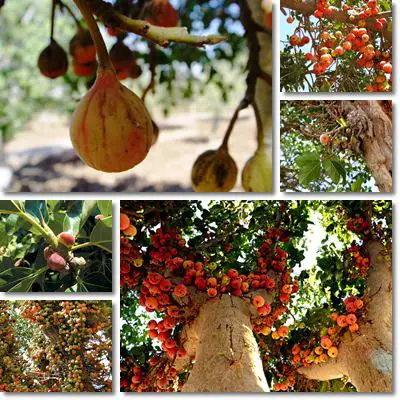The sycamore fig (Ficus sycomorus) is a fig species in the mulberry family, hence its alternative name, fig mulberry. The species dates back to ancient Egyptian times and, despite what its name suggests, it is not actually a maple tree, but a fig species-proper. The tree boasts an enormous, broad crown and can grow up to 20 meters in height. It prefers frost-free, warm climates and can be found growing near rivers, streams and in woods. It can be found in Asia Minor, Syria, Persia and the Mediterranean basin as well as Egypt and can thrive in virtually any country with a tropical climate.
What does the sycamore fig look like?
The sycamore fig tree is a monstrous appearance, tall and wide, with green-gray bark and large, heart-shaped leaves that resemble those of the mulberry tree. The fruit are about the same size and shape as the common fig and come in a range of colors.

Unripe sycamore figs are green and hard. But, as the fruit ripen, their skin turns a deep yellow-red, orange or red-purple and they soften. The flesh is a pale yellow and has a soft texture as well as numerous tiny, round seeds. If cut, the tree oozes a white, slightly sticky latex that causes an irritation or rash when it comes into contact with the skin, a protection mechanism also present in the common fig. It is also possible for contact with sycamore fig or ingestion of fruits or other preparations to cause allergic reactions.
What do sycamore figs taste like?
Unlike common fig varieties, the sycamore fig has a moderate sweet taste, soft-textured flesh and an overall mild flavor, somewhat inferior to that of regular figs. The flowers need to be pollinated by a small wasp species called Ceratosolen arabicus in order to produce fruit which generally ripen from July to December. The fruit grow in clusters and make for a wonderful picture of abundance.
As far as nutritional content is concerned, there is little research on sycamore figs. However, traditional medical practices recommend several parts of the plant, namely the fruit, seeds, leaves and even bark, for the treatment of skin problems, cough, abdominal pain and general weakness. The plant parts are also said to boast anthelmintic, anti-inflammatory and laxative properties. Here is what sycamore fig is said to be good for:

Uses and benefits of sycamore fig
Cracked skin, ulcers, warts and burns
Traditional medical practices of indigenous South American peoples recommend applying the white latex on cracked heels to prevent infections and allow for heeling. The milky latex was also applied on burns, warts and ulcers as a sort of protective layer and to prevent infection.
Cough and other respiratory ailments
According to the Smithsonian Institution, South American tribes used boiled fig bark as a throat-wash for treating cough. The boiled tree bark was drank in the hope of treating respiratory ailments such as sore throat, scrofula (a sort of lymph nodes infection) and even lung problems.
Malaise or general weakness
Malaise refers to a feeling of general weakness. According to research (Nutritional and Phytochemical Composition of Utu (Icacina Senegalensis) and Sycamore (Ficus Sycomorus) Seeds), sycamore fig seeds are a good source of dietary minerals, notably calcium, magnesium, phosphorus, potassium, zinc, copper and iron.
Dietary minerals contribute to a feeling of wellbeing as a result of their tonic properties and can thus successfully treat malaise. However, sycamore figs also contain antinutritional constituents such as oxalate and phytate which may inhibit vitamin and minerals absorption. Cooking the seeds significantly reduces the amounts of antinutritional constituents, allowing for nutrient absorption.
Diarrhea, dysentery and abdominal pain
Sycamore figs have been shown to contain trace amounts of important dietary minerals such as magnesium, potassium and sodium, among others. Magnesium is great at regulating muscle activity and can help ease muscle spasms and cramps and even relieve, to a certain extent, abdominal cramps.
Potassium regulates body fluids, regulates blood pressure and prevents dehydration that occurs when the body loses liquids, electrolytes and dietary minerals as a result of diarrhea or dysentery. The small amounts of sodium in the fruit contribute to maintaining normal blood pressure, preventing dehydration, help ease and possibly relieve diarrhea. The Massai people are said to have used the bark for treating diarrhea.
Antimicrobial properties
The seeds of the sycamore fig have been shown to contain saponins, natural compounds that protect plants from bacteria and fungi. It is believed that eating the seeds can offer similar protection against microbes.
Good for constipation
Sycamore figs are a good source of dietary fiber, represented especially by their seeds content. The seeds are not digestible and pass through the digestive system unchanged, similar to kiwifruit seeds or common fig seeds, contributing to constipation relief. Some sources also say that the root of the plants possesses laxative properties as well.
Also see the benefits of figs.
Good source of carbohydrates
Although not as sweet as the common fig, sycamore figs do contain good amounts of natural sugars which are basically simple carbohydrates that release energy soon after digestion. Eating sycamore figs can thus give you a good energy boost.
Other uses of sycamore figs
According to Duke’s handbook of medicinal plants of the Bible, tribe women would eat sycamore fig leaves and fruits to stimulate lactation. Fruit extract was found to exhibit antitumor activity. Chest ache, snakebites, typhoid, jaundice and several other conditions were treated in the past with various parts of the sycamore fig plant. Last but not least, the yellow, orange and red color of sycamore figs skin may indicate the presence of powerful carotenoids, but further research is required to identify them.
Conclusion
Although there is little research conducted on the properties and benefits of sycamore figs, folk medicine has put the fruit to test in great ways which shows there is much more to learn about its curative properties. Sycamore figs date back to biblical times and represent a wonderfully nourishing fruit with a good dietary mineral and carbohydrate content.
